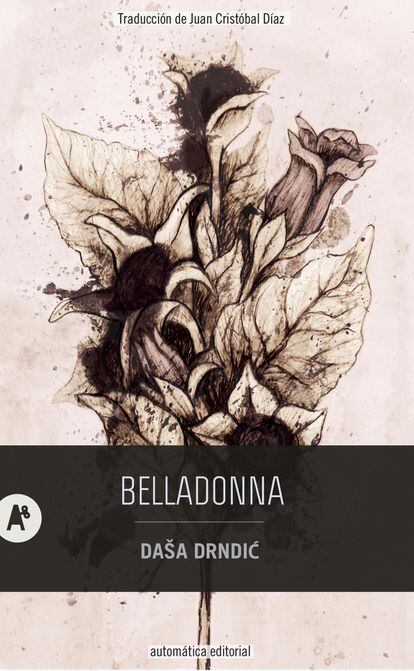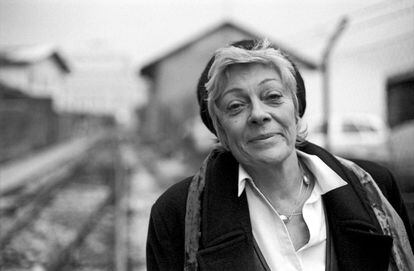Between the pages of the novel Trieste (Automatic, 2015, translation by JC Díaz)by the Croatian writer Daša Drndić (Zagreb, 1946-Rijeka, 2018), there is a list with 9,000 names of Jews deported or murdered in Italy and in the countries occupied by this country between 1943 and 1945, during the Operationszone Adriatisches Küstenland. In that echo of humanity there are resonances of sadness and denunciation. As Zoran Ferić, president of the Croatian Society of Writers, said, “[Drndić] “I was convinced that the most effective way to fight against the destructive ideologies and general dishonor of the last century, but also of the present, is with literature, with a document, specific images and the names of the victims.” Belladonna, His most recent work released in Spain (Automática, 2023, translation by JC Díaz), uses the autobiographical story to reflect on the disintegration of Yugoslavia and the Second World War.
The protagonist of Trieste, Haya Tedeschi, is an elderly woman of Jewish origin who reviews her life in Gorizia, in northeastern Italy, and to do so she uses a collection of letters, testimonies, objects, images that narrate her childhood, but also the terror of the Holocaust. The author felt the vocation to exhibit what the writer Danilo Kiš called “fragments of written monuments.” In this case it is a relationship of microstories, like a novel made up of scraps that ends up coming together in a narrative constellation that aims to bear witness to tragic lives. “His work vindicates memory, identity, and history again and again, which forces us to ask ourselves questions that are sometimes too uncomfortable about the human condition and puts us before a mirror into which it is necessary to look,” points out the editor of Automatica, Alicia López González.
His work penetrates readers through the scrupulousness of the historiographer, with the thoroughness with which one pours over an archive or tackles artisanal work. Not in vain, Drndić complained bitterly that his literature was watered down in translations, he wanted it to rip as incisively as he did in Croatian. This sharp methodology had a lot to do with the idea that past crimes should hurt us as much as the fear of holding broken glass, according to the metaphor used by Ruth Klüger, Holocaust survivor and literature specialist.

Although Drndić knew the arts of entertainment and frivolization, from her time as a playwright at Radio Belgrade and as an editor at Yugoslavian television, her literary mission, especially after her years as a refugee in Toronto (1995-1997) , when he published Marija Czestochowska još uvijek roni suze ili Umiranje u Torontu (Maria Częstohowska still shedding tears or dying in Toronto, 1997) and War song (1998), is to absorb ourselves with an epidermal intimacy that immerses us in the characters from closeness and criticism against oblivion. One of the writer's obsessions is to reflect how official stories silence the true protagonists. To do this she resorted to a kind of chromogenic development in literary format. The paradigm of this strategy is her second novel published in Spain, Leica Format (Automatic, 2021, translation by JC Díaz), focused on the Croatian city of Rijeka, where the writer spent her last years. In this work, reality is amplified and parceled out, as if it were a photo album, in a list of characters that expose us to the dehumanization of the other, to fascism and to silenced memory.
In fact, in all his novels there are passages in which the setting is projected over the locations where horrors occurred, as if it were a work by the visual artist Shimon Attie; For example, it happens in EEG (2016), his last novel published before he died in 2018, in which he narrates: “Let's imagine that we look through the window at Josef Konforti, born in Travnik in 1912, who talks to customers in his store, surrounded by radios, bicycles, typewriters and sewing machines, while other merchants look at the new editions of local and foreign authors. Josef Konforti was murdered in Jasenovac in 1944. The victims thus come to life as we do when we stop to observe a stolpersteine (plaque on the ground or pavement in any European city that commemorates a victim of Nazism).

Drndić followed in the footsteps of other writers who extensively addressed the fate of victims of the Holocaust or totalitarianism, such as Danilo Kiš, Aleksandar Tišma, Dubravka Ugrešić or David Albahari, for whom the Jewish genocide was not only the result of the perversions of a Nazism with a designation of origin, which results in a systematized and industrialized massacre, but rather a process of unc
ivilization where there are constants that are predestined to be repeated and also relocated. The author assumes that massacres are cyclical processes and literature must adopt the function of sounding the alarm. In Leica Format uses a pathological simile to explain to readers the trickery of fascism, as a disease that emerges frantically after a period veiled by peace and tranquility: “Syphilis is a fearsome, latent disease, a true internal enemy that stalks incessantly.” , until, unexpectedly, he assaults his victim.”
An intense need to desacralize the nation and question its cognitive conditioning factors is perceived throughout his work: loyalty, purification and subordination, as well as the mechanisms of social control that identity collectivism exercises over the freedom of the individual. Already in life she was a staunch opponent, during the fragmentation of Yugoslavia, both of the Serbian president Slobodan Milošević, in the years in which she lived in Belgrade, and of the Croatian president Franjo Tuđman, upon her return to Croatia, after being forced to leave the Yugoslav capital at the beginning of the 1990s due to pressure from Serbian nationalism.
/cloudfront-eu-central-1.images.arcpublishing.com/prisa/QLPOL635EFGQXL7FUQV5LF5EJM.jpg)
In that sense, Belladonna It is her most autobiographical work, where the author's frictions in her time as a university professor are revealed, the clash of values with the educational system during the training of her daughter Maša or the inclemencies experienced within the Croatian health system. His alter ego, Andreas Ban is a retired and sick professor in decline, but armed with mordacity and erudition in the face of an environment where the crisis of values of ethnocentrism, the consumer society and superficiality in culture prevail. Like in Triesteaccompanies the text with a long list of the 2,061 Jewish children deported from the Netherlands to concentration camps between 1938 and 1945, along with a quote from the German artist Gunter Demnig: “People are forgotten the moment we forget their names.” ”.
All the culture that goes with you awaits you here.
Subscribe
Babelia
The literary news analyzed by the best critics in our weekly newsletter
RECEIVE IT
Subscribe to continue reading
Read without limits
_
#Daša #Drndić #writer #digs #memory #narrate #conflicts #Balkans